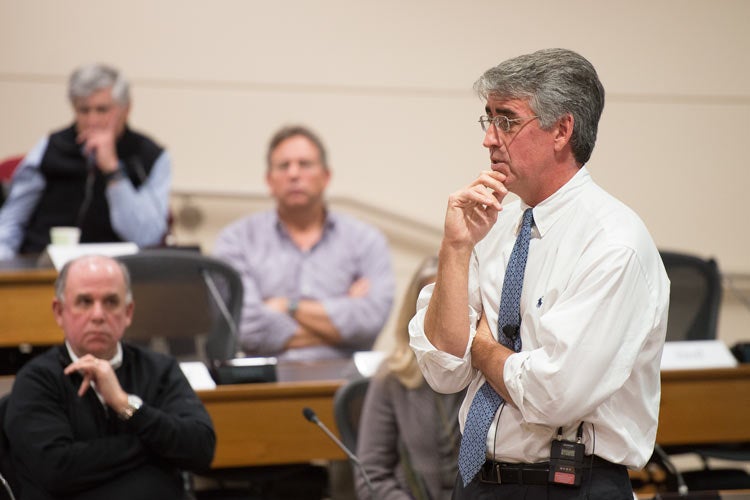
William Maloney addressing the Faculty Senate on the issue of concussions in collegiate athletics. (Image credit: L.A. Cicero)
While concussions among college football players have received a lot of attention, brain trauma is also an issue for student athletes in nearly every sport. That includes women’s soccer and water polo players, as well as students who play club sports, a Stanford Medical School professor told the Faculty Senate yesterday.
Speaking at Thursday’s senate meeting, William Maloney, an orthopaedic surgeon and Stanford’s representative on the Coalition on Intercollegiate Athletics, stressed that concussions among student athletes are not just an issue at Stanford, but are also a national problem at all levels of athletics.
Maloney defined a concussion as a change in brain function following a force applied to the head, which may be accompanied by temporary loss of consciousness, but is also identified in individuals who are awake, with measures of neurologic and cognitive dysfunction that can affect athletic as well as academic performance.
During the academic year 2011-12, Stanford Athletics reported about 40 concussions. During 2013-2014, the number rose to about 55.
Maloney attributed the increase, in part, to improved efforts to monitor incidents.
“We’re tracking them better,” he said. “We’re reporting them better. Surveillance is better.”
Maloney also noted that concussions can be caused by an athlete making a sudden stop, jarring the brain inside the head. It doesn’t take a direct blow to create a concussion, he said.
“For you as educators – for all of us as educators – attention deficit is the most common cognitive problem of a concussion.”
He said Stanford is engaged in many studies regarding concussion, including the Pac-12 Concussion Study in Female Athletes, a collaboration between Stanford, the University of California, Berkeley, the University of Utah and the University of Oregon.
In addition, the U.S. Department of Defense recently awarded $12 million over a three-year period to the Stanford School of Medicine to establish a multi-institutional consortium to develop a new brain-trauma classification system that will lead to effective diagnostics and therapeutics.
Also, a team of engineers and physicians at Stanford has provided the first-ever measurements of all the acceleration forces imparted on the brain during a diagnosed concussion. Their study was recently published in the Annals of Biomedical Engineering. The findings could lead to better injury detection, or toward developing safer protective gear.
Building for a more connected campus
University Architect David Lenox on Thursday gave the Faculty Senate a whirlwind virtual tour of buildings that have helped transform Stanford’s central campus in recent years, including the Knight Management Center, the Science and Engineering Quad, Stanford Law School, Lathrop Library and the Windhover contemplation center.
He also talked about the principles that drive planning and building design on campus: encouraging and enhancing connection; creating facilities for interdisciplinary collaboration; strengthening the residential campus; and stewarding Stanford’s lands and operations.
He cited the McMurtry Building for the Department of Art and Art History as an example of Stanford’s commitment to encouraging and enhancing connections.
“We’re getting bigger, yet we’re starting to work together even more than we have before, so how do you connect people?” he asked. “How do you get people moving around? We don’t want to create all these insular little villages in academia, we want people to experience the whole campus.”
Lenox used the McMurtry Building, the future home of art history, arts practice and film studies, as an example, showing an interior diagram of the building. Construction is under way and the building is expected to open this year.
Lenox said the design of the building “celebrates the tension that often happens between art history and the making of art,” adding that not many universities have art history and arts practice in one department.
“This diagram of the building is about putting all of the making of art in one wing, and all of the studying of art in the other wing, and they embrace each other,” Lenox said, showing several views of the building’s interior design.
“There are three places where these groups come together – a covered, first-level courtyard, a library on the second level and a third-level rooftop where design studios and classrooms can spill out.”
Lenox said that like the other new buildings in the arts district – Bing Concert Hall and the Anderson Collection at Stanford University – the McMurtry Building is “a little more expressive, a little more sculptural, a little more reflective of the program within.”
The full minutes of the Jan. 22 meeting will be available on the Faculty Senate website next week. The minutes will include the question-and-answer session that followed the presentations. The next senate meeting will be held Feb. 5.